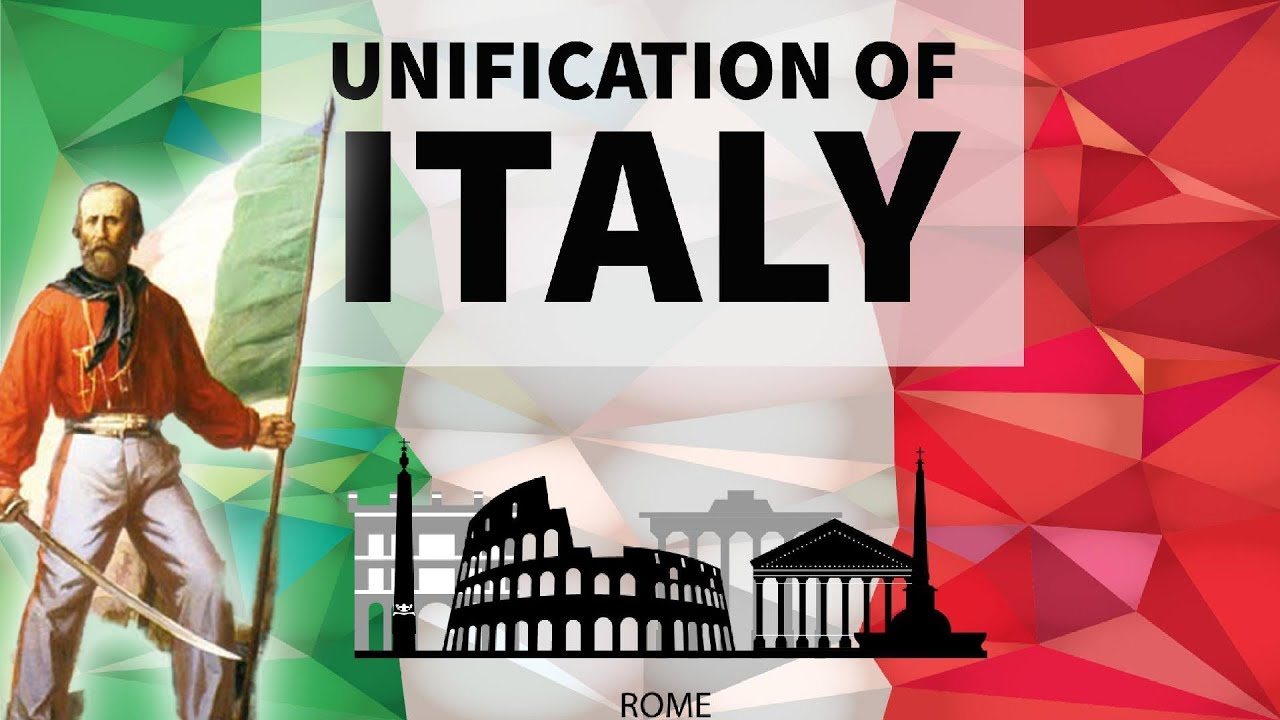
Unification of Italy- UPSC
On March 17, 1861, the Parliament of Sardinia proclaimed the creation of the Kingdom of Italy. This act was one of the results of the Risorgimento (Italian – revival, renewal) – the national liberation movement of the Italian people against foreign domination, for the unification of fragmented Italy.
At first, military operations against Austria did not bring success to the Italians. During the Austro-Italian War of 1848-49 (First Italian War of Independence), the alliance of Italian states was defeated. As a result, the king of Sardinia Charles Albert, who led the coalition, was forced to abdicate, most of Italy remained under Austrian rule, and Rome was occupied by the French.
However, this war played an important role in raising and spreading patriotic feelings. During the Austro-Italian-French War of 1858 (Second Italian War of Independence) and the subsequent landing of Garibaldi’s troops in Sicily, the Kingdom of Sardinia was unified with Lombardy, Tuscany, Romagna, Parma and Modena.
A plebiscite held in October 1860 in the south of the country approved the merger of Naples and Sicily with the Kingdom of Sardinia. And in November, as a result of plebiscite, it also included Umbria and Marche. Thus, by the end of 1860, the main part of Italy was effectively united under the rule of the Sardinian dynasty. The de facto situation was soon legalized – on March 17, 1861, the Parliament of Sardinia proclaimed an independent Kingdom of Italy with its capital in Turin. Its head is the son of Charles Albert, King Victor Emmanuel II. In 1865 the capital was moved to Florence.
However, not all of Italy’s territory was unified. Part of the Italian Peninsula was still under the rule of Austria, and in Rome, occupied by French troops, the power of the Pope remained.
During the Austro-Prussian-Italian War of 1866 (Third War of Independence), Italy sided with Prussia and managed to annex the remaining Italian lands, including the Venetian region. In September 1870, Italian troops entered Rome, from which by that time the French troops had been withdrawn.
After the liquidation of the Papal States in 1870, the capital of the kingdom was moved from Florence to Rome. The Kingdom of Italy became the first state to control the entire Italian Peninsula (except for the small enclave of San Marino) since the Byzantine Empire lost control of the peninsula.
The unification of the country was accompanied by the unification of legislation, judicial, monetary and customs systems, system of measures and weights, and taxation. This opened the way for the economic convergence of the scattered territories. Thanks to the rapid construction of railways (their length increased from 2,500 km in 1861 to 6,200 km in 1871), the main regions of Italy were interconnected. As a result, favorable opportunities arose for a more rapid folding of the single national market.
How was Italian unity achieved ?
Below information of Unification of Italy is very important for UPSC exams-
1. The rise of nationalism
In the early 19th century, Italy was fragmented into seven states and were dominated by Austria . Yet a movement made up of bourgeois (capitalist) and intellectuals, believed in the rebirth of a unified Italy. These intellectuals organized themselves in a secret society because of the violent repressions that Austria imposed on the revolutionaries. Two republican movements were formed: one republican was led by Mazzini and Garibaldi ; the other, less democratic, was made up of large industrialists and large landowner soften nobles and capitalist. Very different from each other, all these patriots were at least in agreement to get rid of the hegemony of Austria.
2. The failure of republican aspirations
In 1847, the King of Piedmont, Charles-Albert, transformed his absolutist state into a liberal state. In 1848, the revolution broke out in many cities. In Venice and Rome the Republic was proclaimed. Adopting the Italian tricolor, the king of Piedmont Charles-Albert led the national movement and declared war on Austria . But he was crushed in 1849 and forced to leave the throne to his son Victor-Emmanuel II . Venice capitulated while Pope Pius IX reestablished absolutism in Rome. This first attempt at national union was a failure. It seemed that Italy could not unify without there being foreign intervention.
3. The creation of a unified kingdom
The Camillo Benso, Count of Cavour, the minister of Victor-Emmanuel II, then had the idea of asking for help from France. In 1859, in exchange for the annexation of Savoy and Nice to France, Napoleon III sent the French army to help Piedmont in a war against Austria. In 1860, an armed expedition led by Garibaldi, called the Expedition of the Thousand , conquered Sicily and Naples. The men who made it up were called the Red Shirts because of their scarlet uniforms. Very quickly, the unitary movement gained the whole country and Victor Emmanuel II was proclaimed King of Italy. The unit ended in 1870 with the capture of Rome, which was still in the hands of Pope Pius IX, by the troops of unified Italy.
Unification of Italy in points
The main events for the unification of Italy in the 1850-1860s can be presented in the form of a table/points:
| date | Event |
| April-July 1859 | Austro-Italian-French War. It resulted in the annexation of central and northern Italy to the Sardinian kingdom of Victor Emmanuel II. His ally was the French emperor Napoleon III, to whom Nice and Savoy were transferred |
| 1860-1861 years | Expedition of the detachment under the command of the national hero Giuseppe Garibaldi to Sicily, and then to Rome from the south. The lands of the kingdom of both Sicilies and the Papal States became part of the Sardinian kingdom |
| March 17, 1861 | Date of proclamation of the independent kingdom of Italy, Victor-Emmanuel became king |
| 1866 year | Austro-Prussian-Italian War, Austria was defeated and transferred to Italy the Venetian region, from Ferrara to Oudinot |
| 1867 year | Giuseppe Garibaldi, with a detachment of several thousand volunteers, tried to liberate Rome, but was defeated by the French corps in the city. |
Read about Treaty of Rome 1957
Unification of Italy summary in points:-
-
The country was fragmented back in the Middle Ages. Neither kings, nor popes, nor other representatives of the aristocracy were interested in unification.
-
Since the same time, there have been differences between the agrarian South and the industrial and commercial North.
-
After the king of the Sardinian kingdom entered the war against revolutionary France in 1791, Northern Italy became the scene of the revolutionary wars of France and anti-French coalitions. Many events are associated with the name of Napoleon. His military campaigns continually redraw the country’s map and strike at kings and aristocrats who oppose unification.
-
After the defeat of Napoleon and the Congress of Vienna in 1814-1815, much that was created under Napoleon is canceled. The Austrian Empire is becoming one of the main obstacles to future unification.
-
Back in 1807, secret societies of the Carbonari (“coal miners”) appeared on the territory of the Kingdom of Naples. They advocate the unification of the country. But Austrian troops are suppressing the movement. The revolutions in Piedmont, the Sardinian kingdom also end in failure. Further uprisings of the Carbonari are suppressed.
-
A new idea of unification is put forward by Giuseppe Mazzini, who creates the revolutionary organization “Young Italy”. But new uprisings and conspiracies also do not lead to success.
-
In the 40s, industrial growth begins in Northern Italy. The bourgeoisie and the intelligentsia are making more and more demands on the monarchs. The idea of unification under the rule of the Pope appears (it is put forward by Vincenzo Gioberti).
-
In 1847, Count Camillo Cavour begins publishing the Risorgimento (Renaissance) newspaper. It gives the name to the era of the struggle for unification.
-
New Pope Pius IX carries out liberal reforms. Then the Austrians conduct military exercises on the border of the Papal States. The refusal of the inhabitants of Northern Italy from tobacco (since the Austrians have a monopoly) leads to clashes and demonstrations. The inhabitants of Sicily and the Kingdom of Naples revolt, and the Piedmont (Kingdom of Sardinia) declares war on Austria. A republic is created in Rome with the participation of Mazzini and Garibaldi. Italy is one step away from unification, but the revolution is defeated.
-
The main reasons are that the Italian patriots are fragmented. The bourgeoisie does not call on the peasantry for help. But Piedmont becomes, in the eyes of the Italians, the only possible unifier of Italy.
-
A decisive contribution to the unification is made by the campaign of the “thousand” Garibaldi in 1858. He manages to overthrow the rule of the Neapolitan Bourbons.
-
On March 17, 1861, a unified Italian kingdom was proclaimed, headed by the King of Sardinia, Victor Emmanuel.
-
In 1866, after the war with Austria and with the support of France, Italy conquered Venice from Austria, but was deprived of Savoy and Nice in favor of France. In 1870, during the wars with Germany, France withdraws its troops from Rome, and the “eternal city” becomes the capital of the united Italy.
-
There are still many problems. Among them are the gap between the North and the South, the country’s lack of money, the dependence of the peasants on the aristocrats, limited voting rights, and others.
-
After the death of King Victor Emmanuel II, the new king, Umberto, begins colonial wars of conquest in Africa. An attempt to seize Ethiopia in 1895-1896 ends in shameful failure. In foreign policy, Italy is changing its traditional allies. All of this negatively affects the economy, and the geographic and political divide remains insurmountable.
-
At the end of the 19th – beginning of the 20th century, the industry of Northern Italy developed rapidly, but in general the country remains agrarian. The labor movement is gaining momentum, peasant uprisings are taking place.
-
In 1901–1902, after workers’ uprisings and strikes, the Giolitti government introduced labor legislation and universal suffrage (for men). But he also suppresses the rise of socialist and left-liberal sentiment by fomenting nationalism. This policy brings Italy into the First World War.
Related Articales
Recently Posted
-
भगवान गौतम बुद्ध जीवन परिचय | Gautam Buddha in Hindi
December 15, 2022. -
कार्बन के अपररूप Allotropes of Carbon in Hindi
November 5, 2022. -
मिश्र धातु किसे कहते हैं? उपयोग, नाम, गुण Alloy in Hindi
July 27, 2022. -
गलनांक किसे कहते हैं? परिभाषा, उदाहरण Melting Point in Hindi
July 20, 2022. -
परिमाप किसे कहते हैं? Perimeter in Hindi
July 19, 2022.




